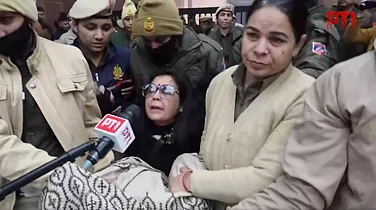It took six long years for Jarnail Singh Bhindranwale to build cult status among his supporters before his bullet-ridden body was found in the debris inside the Golden Temple following Operation Bluestar in 1984.
Amritpal Singh, who styles himself as Bhindranwale, escaped the police dragnet and remained on the run for several days and sought to take over the latter’s mantle within six months of his appearing on the scene.
There is no doubt that the advent of Amritpal Singh and his activities had raised the spectre of militancy as had happened in Punjab four decades ago with Bhindranwale leading the so-called Khalistan movement. The nightmare of death and destruction is still vivid in the memories of those who had lived through the period or those who had lost their dear ones then.
This also partly explains the lack of any groundswell of protests against the police hunt to nab him and his followers. In fact, barring an ongoing protest for the release of ‘Bandi Singhs’ or the release of arrested militants who had already completed their sentences, no protest was reported in the state after the police crackdown.
Unlike Bhindranwale, who was a preacher and who had meticulously built up his support base after a long struggle, Amritpal had virtually para-dropped into the state to take up leadership of the radical fringe.
All that is known about him is that he was a truck driver in Dubai and had been active on social media groups frequented by separatists and those with radical views. In the photographs sourced from his web profile, he is seen clean-shaven and trim, unlike his new avatar in which he is seen adhering to the five symbols of the Sikhs - Kesh, Kanga, Kutcha, Kara and Kirpan (long hair, comb, underwear, bracelet and sword).
Amritpal suddenly emerged on the scene after the Lok Sabha by-election for Sangrur constituency which was won by radical leader Simranjeet Singh Mann after a crushing defeat of the Aam Aadmi Party candidate despite the fact that it was vacated by Bhagwant Mann after he took over as the chief minister. Simranjeet Singh Mann, who was last elected to the Lok Sabha about 25 years ago, had been consistently losing his support base (which also reflected the progressive reduction in support base for those with radical ideologies) and the vote share of his party had reduced to a mere 1.5 per cent in the 2019 Lok Sabha elections.
His thumping victory in the Sangrur by-election was a clear indicator that the voters, who had earlier cast away the Congress and the Shiromani Akali Dal, had also turned their ire towards the AAP government led by Bhagwant Mann. Evidently, Amritpal, and those backing him, thought the time was ripe to revive the demand for Khalistan by exploiting the anger and frustration amongst the youth in the state.
With the help of forces backing him, he sought to attract a section of frustrated and misguided youth by talking of the return to true Sikh traditions and seeking to eradicate the problem of drugs in the state.
Under very mysterious circumstances, he took over the mantle of the organisation ‘Waris Punjab De’ (Heirs of Punjab) which was earlier headed by actor and activist Deep Sidhu, who had died in a road accident. Even as his family members said they had nothing to do with Amritpal Singh, the latter took over its leadership and began mobilising a section of youth.
His moment of reckoning came in less than six months of his arrival on the scene when he and his supporters stormed a police station to protest against the arrest of one of his followers. Several policemen were injured during the attack and this set up the stage for a confrontation and led to the crackdown on him and his supporters.
However, what he and his supporters had done while attacking the police station was never done by Bhindranwale, or for that matter, by any Sikh leader in the past. Amritpal and his supporters used the Holy Guru Granth Sahib, as a shield while standing off with police. This tied down the police from retaliating. This action of Amritpal was roundly criticised by the vast majority of Punjabis, particularly the Sikhs, and he appeared to have lost sheen after this act. It may partly explain the lack of any popular rising after the police crackdown to nab him.
Then he did what Bhindranwale had never done. He ran away and escaped the police dragnet. All during his six-year journey, from 1978 when his supporters who had clashed with ‘Nirankaris’ in Amritsar and had suffered casualties, to his death under a hail of bullets in 1984, he had never tried to run away from security forces. Bhindranwale had in fact courted arrest and was released after no evidence was found against him in the case of the murder of a senior editor.
Bhindranwale was a preacher unlike Amritpal and had slowly and steadily built up his support base while Amritpal’s background and the forces backing him continue to remain under a shroud of mystery. For the vast majority of the residents of Punjab, the wounds of the militancy are still raw and they shudder to think about any kind of militancy in the state. No wonder there were more protests by Khalistani supporters outside the country than inside it.























